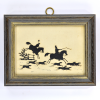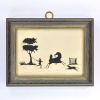Barber, C. A, Master
Introduction:
Born CHARLES LEWIS ALBERT BARBER (1840-1901), as 'Master C.A. Barber' he began cutting freehand silhouettes commercially from the age of 8. Cut from black or blackened paper laid on card mounts measuring no more than 5" x 3", all recorded compositions depict equestrian or farmyard scenes.
The reverse of 2 works are inscribed in a contemporary hand "Cut Out By C.A.Barber, Aged 8 Years, Soho Square 1848" and "C.A.Barber, Aged 10 Years, Attends Every Afternoon At Counter 440, Soho Bazaar, Soho Sq.".
Soho Bazaar was opened in 1816 by army contractor John Trotter, who had earlier rebuilt nos. 4,5 and 6 Soho Square into a warehouse. After the Napoleonic War he adapted it into a bazaar primarily for widows and daughters of army officers to sell their handiwork. Stalls and counters were hired by the day at 3 pence a foot. The venture was highly successful and described in 1843 as "still standing at the head of its class". It inspired various imitators including Oxford Street's Pantheon Bazaar.
Barber's works are competently cut, have charm, and coupled to his young age, it was probably reason enough for his efforts to be displayed at the Great Exhibition of 1851. The official catalogue records how Barber cut "...figures and landscapes out of paper with scissors, no design having been first traced...". The facility appears inherited, as recent research discovered his father was freehand cutter and sometime painter Charles Lewis (Louis) Barber (1797-1845), who in 1820s advertisements claimed to cut a likeness in "...10 seconds without the aid of drawing or machine".
It appears unlikely Barber Snr honed his son's cutting skills, as according to his lengthy obituary, he had resided alone in Cambridge from 1844 until his death there the following year, when son 'Master' Barber would have been under 5 years old.
In January 1822 Barber Snr married Elizabeth Hopley (1804-1861) in her home town of Dover. 'Master' Barber's brother, Charles Lewis Augustus Barber, was baptised in April 1824 in Yorkshire, and his sister Eliza Hopley Barber, was baptised in Dover in December that year. It's worth noting that Eliza became an accountant and assistant to pioneering daguerreotype photographer Antoine Claudet (1797-1867) at the Adelaide Gallery in London's Strand sometime in the early 1840s. As her father is presumed to have cut silhouette profiles at the Gallery, it's entirely possible he helped secure her employment there.
Recent research discovered Barber Snr to have been a 'colourful' character. A serial bigamist, aeronaut, and twice an insolvent debtor, he also claimed fraudulently to have been a captain in the 15th Hussars and present at Waterloo. Additionally he altered or added to his given names in records to accommodate his varied circumstances.
Also a curious circumstance is that as well as inheriting a modicum of his father's artistry, 'Master' Charles Albert Barber, as an adult, also developed a penchant for altering his own name.
In the 1851 Census, the year Charles Albert's works were displayed at the Great Exhibition, he is recorded in London as an 11-year-old "scholar". His widowed mother is described as a "Dealer in Miscellaneous Articles", which possibly suggests straitened circumstances.
Charles Albert then disappears from records until 1874, though at some earlier point he became a wood engraver. AMSTERDAM CITY ARCHIVES show him working in the city and in Brussels between June 1874 and September 1879. However, he also returned to England sometime in 1876, long enough to register his marriage to German-born Fredericke Wilhelmine Roesler, where he gives his name as Charles A.O. Barberé. His wife would give birth to 4 offspring between 1880-89.
In the 1881 Census he records his occupation as "Xylographer", a more opaque term for his craft, and probably intended to bemuse the enumerator. He gives his name as Charles A.O. Barberé, born in Warwickshire in 1840. In 1891 he records his occupation as a wood engraver and his name as Albert O'Pley Barberé!
The 1901 Census finds him a patient at the Holborn Union Infirmary (Islington) as Charles Albert Barberé, a retired 60-year-old wood engraver. It's unlikely he left the facility alive, as an Albert Barberé's death was registered in Islington between April and June 1901.
Revised 5 April 2024 (Brian Wellings)
Additional research about Master C. A Barber:
Source: McKechnie (Author of, British Silhouette Artists and their Work 1760-1860)
Barber, C. A, Master (McKechnie Section 1)Source: Joll (Hon. Secretary of the Silhouette Collectors Club and Editor of the Club's newsletter)
Barber, C. A, Master (SCC Newsletter December 2001)Barber, C. A, Master (SCC Newsletter November 1995)


